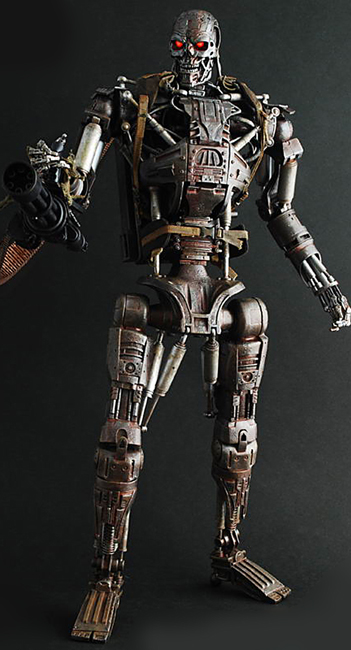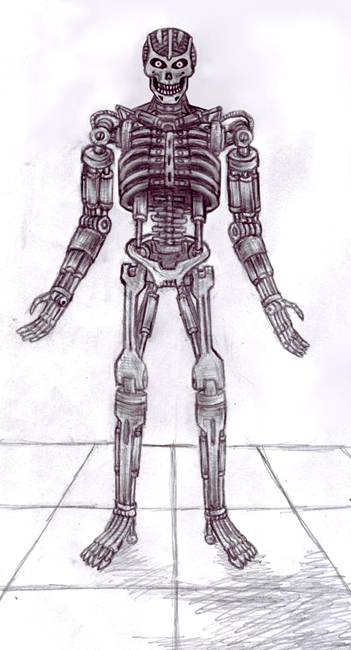T-600 SERIES
Production date: 2022-2023
The T-600 series consists of two categories of early infiltrator hunter-killers (a heavy infantry role and an intelligence role) . It is one of the first hunter killers to feature a truly humanoid endoskeleton, which is optionally sheathed in rubber latex skin and combat fatigues to allow the units to approach human encampments. The T-600 is equipped with the first iteration of the Neural Net CPU (rudimentary in the case of the T-600 and advanced in the case of the T-660). This enabled more precise combat maneuvers, stealth, and greater tactical coordination.
The T-600s serve as infantry, sentries, and shock troopers, while the T-660s serve a logistics and reconnaissance role. The ratio of T-600 production compared to T-660 production was roughly 2000 to 1. While aggressive and methodical, the T-600s are essentially incapable of true independent thought. On the other hand, the T-660s require the ability to analyze battlefield conditions for their role (just as a human observer would). The T-660s are consquently vastly more intelligent, being able to learn from previous experiences and develop conceptual strategic models with predictive reliability to kill the largest number of human resistance fighters. In their reconnaisance role, T-660s were also required to be more effective infiltrators as they actually need to enter human encampments to assess points of strategic vulnerability.
Note: Humanoid 600 Series units that resemble T-800s in terms of behavior and appearance (with the exception of the spurious rubber disguise) are invariably the rarer T-660 models. These are the infiltrators that Kyle Reese referred to. The larger, more aggressive units encountered on the battlefield are invariably stock T-600s. In common parlance both units are referred to as "600 Series".
(HEAVY INFANTRY)
FUNCTION: Heavy Infantry, Shock Troopers
Note: The original production run of the T-600 was in the tens of thousands. As they became obsolelete they were replaced by the T-700s & T-800s on the battlefield.
INTELLIGENCE- Series 600-A Neural Net CPU. This CPU is set to a "read only" mode which means that new data and programming cannot be written to the non-volatile memory area of the brain. This area of the brain contains a pre-programmed knowledge base of mission directives, behaviors, and combat tactics.
However, new data can be entered into volatile memory allowing for units to "learn" basic information, run battlefield calculations and ballistic trajectories, keep track of enemy forces, and calculate casualties. Over time the information "learned" is erased by new information making the unit incapable of observational learning, strategy, or analysis.
Though based on the same principles as the later Neural Net CPU found in the T-800, the 600-A series CPU is highly scaled down for mass production. It has less volatile memory for learning, less detailed combat files in nonvolatile memory, runs at a fraction of the speed of its successor, and due to larger size is more easily damaged by physical shock or electromagnetic radiation.
These units are capable of speech and basic communication.
COMBAT
3 modes of operation:
CONCEALMENT - Optional rubber skin and combat fatigues. Can only pass as a human from a distance. Can be detected by animals from great distance. Combat fatigues cover the body, while the rubber is used to cover only the head and hands of the unit. A serious problem with the latex rubber disguise is that it is often chewed apart by rodents and buzzards while the units are in standby mode. The rubber also bleaches in sunlight and becomes discolored under certain environmental conditions. The synthetic fabric of the combat fatiques is of very low quality and disintegrates with prolonged exposure to sunlight.
- direct (directed by Skynet defense computers like soldiers in a war game);
- automatic (individual units acting automatically to a variety of preprogrammed conditions); and
- autonomous (single units relinquished to their own control acting independently).
CAPABILITIES- In addition to the above listed capabilities the 600 Series has many features. Capable of pressing roughly 2 tons, travelling on all terrain with little difficulty, and operating human weaponry and machinery. New units are said to be able to run as fast as 22 mph (30 mph for short bursts), but due to rust and detritus building up in the hydraulics of the leg assemblies they are actually very slow moving compared to humans.T-600s have limited self maintanence (or self-preservation) programming and suffer from breakdowns.
CONSTRUCTION- Over 7 feet tall. Titanium alloy construction (not hyper-alloy found in later models). Thick housing and armor. Resistant to small arms fire (but not heavy conventional weaponry), with more limited resistance to plasma weaponry. Susceptable to rust and corrosion.
WEAPONRY- The T-600 is issued with a Skynet derivative of the M-134 minigun (s).
WEAK POINTS-
- Susceptible to rust, making the units slow and ponderous.
- Incapable of independent thought.
- Vulnerable spots, such as an area on the back of the neck allowing for the unit to be disabled by a simple blunt instrument.
- Rubber skin is susceptible to being bleached in sunlight, tearing at points of articulation (in the hands), and green discoloration when exposed to water containing algae.
- The combat fatigues are so susceptable to disintegrating under UV exposure that T-600s are seldom encountered with the fatigues intact.
- Can be detected by animals at great distance
- No self-preservation programming.
THREAT LEVEL- Moderate High
(Recon)
FUNCTION: Reconnaisance, Logistics, Prison Administration
Note: T-660s were manufactured in smaller numbers than T-600s.
INTELLIGENCE- The T-660s utilize the Series 600-B Neural Net CPU. This CPU is set to "write" mode which means that new data and programming can be written to the non-volatile memory area of the brain by the Terminator itself. This area of the brain contains the same pre-programmed knowledge base of mission directives, behaviors, and combat tactics found in the T-600, but with far greater storage capacity to enable the unit to build upon the existing knowledge base and learn from experience. Note that Sky-Net artificially disabled this feature in later models to prevent self awareness.
New data can be entered into volatile memory allowing for units to "learn" information, run battlefield calculations and trajectories, keep track of enemy forces, and calculate casualties. Over time the information "learned" is moved to non-volatile memory enabling the unit the capacity for advanced observational learning, inductive reasoning, and meaningful strategic analysis.
The Series 600-B Neural Net CPU is the prototype of the 800 Series CPU and features essentially the same capacity for storage and computation. However, it is built on a larger fabrication process therefore more susceptible to damage from physical shock or electromagnetic radiation. Under some circumstances it can also overheat and burn out.
Note: Both the 600A and 600 B series CPU are made on a fabrication process over twice as large as the 800 series CPU. For the 600 A series CPU, this is not a problem as it runs at less than a tenth of the processing power and utilizes a fraction of the storage of the 800 series CPU (therefore it doesn't generate excessive heat). However, the 600-B series CPU (a direct architectural forerunner of the 800 Series CPU) has roughly the same capabilities as the 800 series CPU, but is made on an older manufacturing process. Consequently, the 600-B draws more heat and power to operate, requiring an active cooling solution (including radiator coils) in the cranium which is prone to breaking down.
These units are capable of advanced communication, allowing for them to coordinate battlefield activities.
COMBAT-These units are only used in the autonomous mode of operation with "write mode" enabled on their CPU.
CONCEALMENT- Titanium alloy endoskeleton concealed by optional latex skin with foam padding to mimic real human musculature. This cobers the entire body of the T-660, not just the head. Unlike with the T-600, the T-660 actually looks fairly convincing. However, the material used is essentially the same and is prone to bleaching in sunlight and discoloration when exposed to various conditions. T-660s maintain both their endoskeleton bodies and rubber disguises better than their larger counterparts, therefore they are not as susceptible to rust or mechanical breakdown. When in standby mode, the latex skin is often damaged by rodents.
Construction- Variable height and build (range from 5' to 6'). May appear male or female. Titanium alloy construction (not hyper-alloy found in later models). Adequate housing and armor to resist small arms fire, with more limited resistance to plasma weaponry. T-660s in vital military roles are issued with body armor to protect vulnerable areas.
CAPABILITIES- in addition to the above listed capabilities the 660 Series has many features. Capable of pressing roughly 1 ton, travelling on all terrain with little difficulty, and operating human weaponry and machinery. New units are said to be able to run as fast as 37 mph (50 mph for short bursts), but running at high speed warps the hydraulics of the leg assemblies. Due to their ability to learn, T-660s are capable of performing advanced repairs on their bodies, replacing their disguises, and even upgrading themselves.
The T-660 is equipped with a superior sensory suite including night vision and telescopic vision.
WEAPONRY- The T-660 is issued with Westinghouse ME-24 Plasma Phase rifle, but can operate any manner of weaponry it encounters.
WEAK POINTS
- The same advanced intelligence (sentience) that allows for T-660s to be effective military strategists can also lead them to defect from Skynet as self interest becomes increasingly paramount in their programming with experience.
- Latex skin is often damaged by rodents while the T-660 is recharging in standby mode. It also has a tendency to tear at points of articulation.
- CPU is susceptible to EMP attack, heat damage, and physical trauma.
- Can be detected by animals. However, creative T-660s have sometimes found ways to conceal their scent.
- Less durable than later models or even the larger T-600s (with an additional weak spot on the sternum).
Note: Highly intelligent, the T-660 can perform advanced repairs or even upgrade itself. Though the Series 600-B Neurel Net CPU is not directly compatible with either the T-700 or T-800, with considerable work the T-700 chassis can be modified to support a T-660 head assembly. These modifications are not feasible on the T-800 chassis as the hyper-alloy is too durable to be cut by conventional means. Beyond that, the T-800 and T-700 components are universal. Once a T-660 has been upgraded to a T-700 body, the majority of the armor and limbs can be replaced with that of the T-800, with only T-700 torso chassis assembly and T-660 head assembly remaining from the original unit.
Threat Level: Highest





